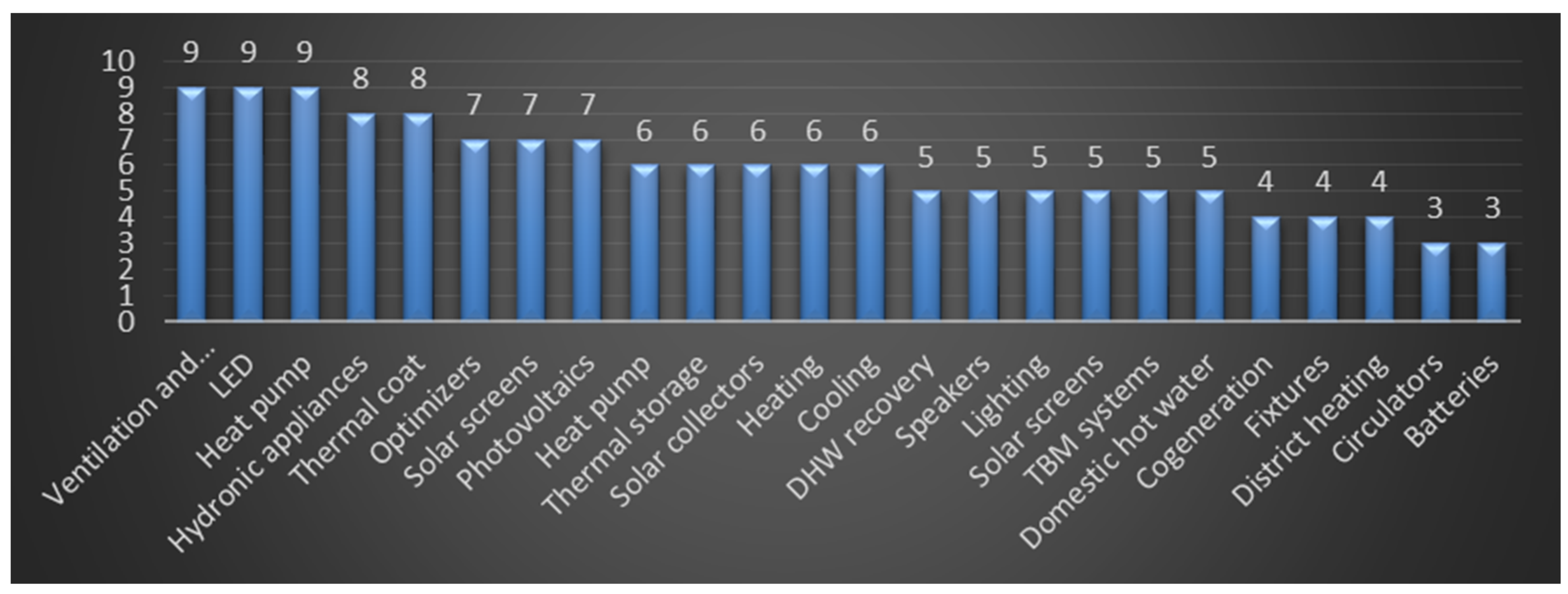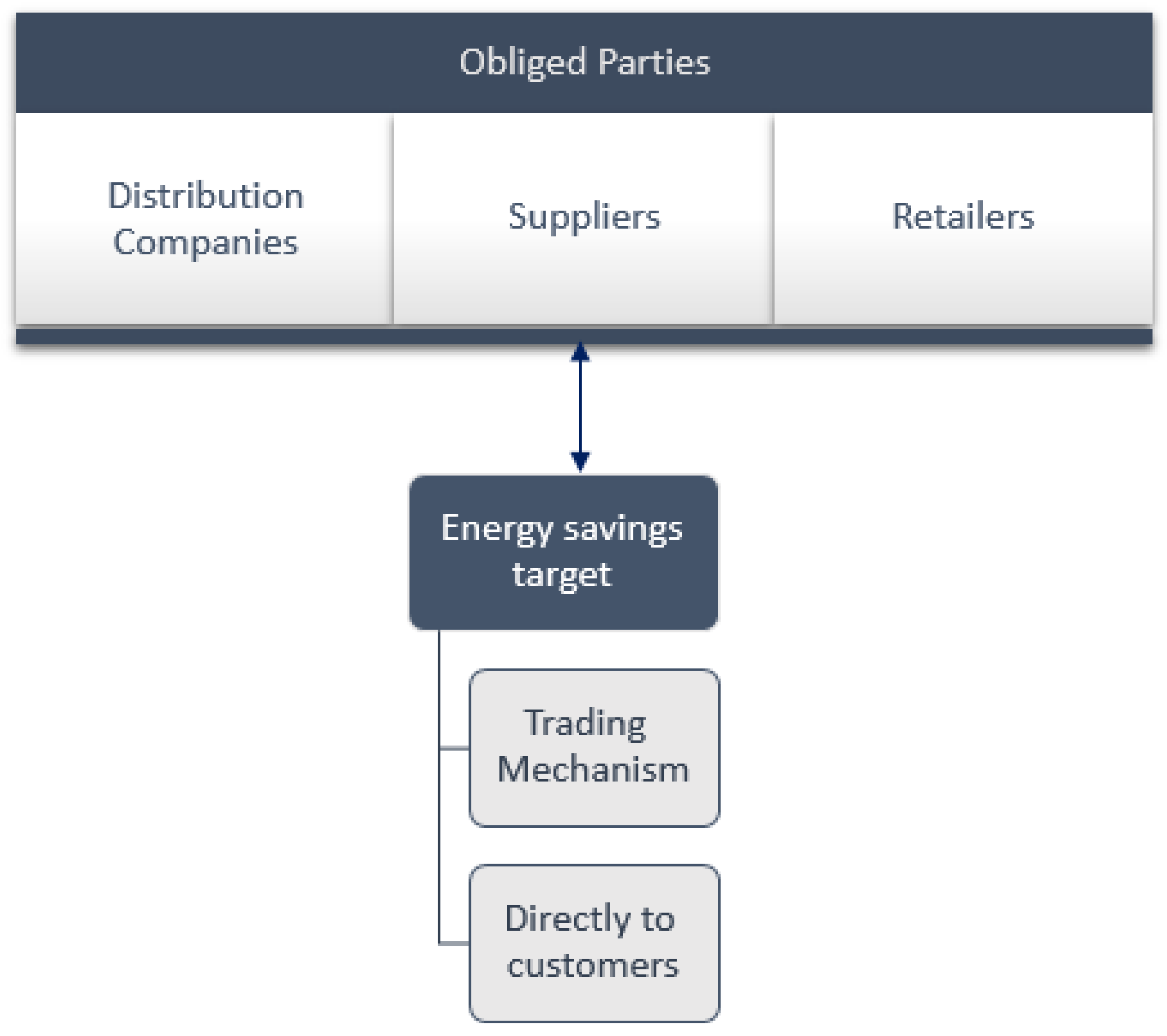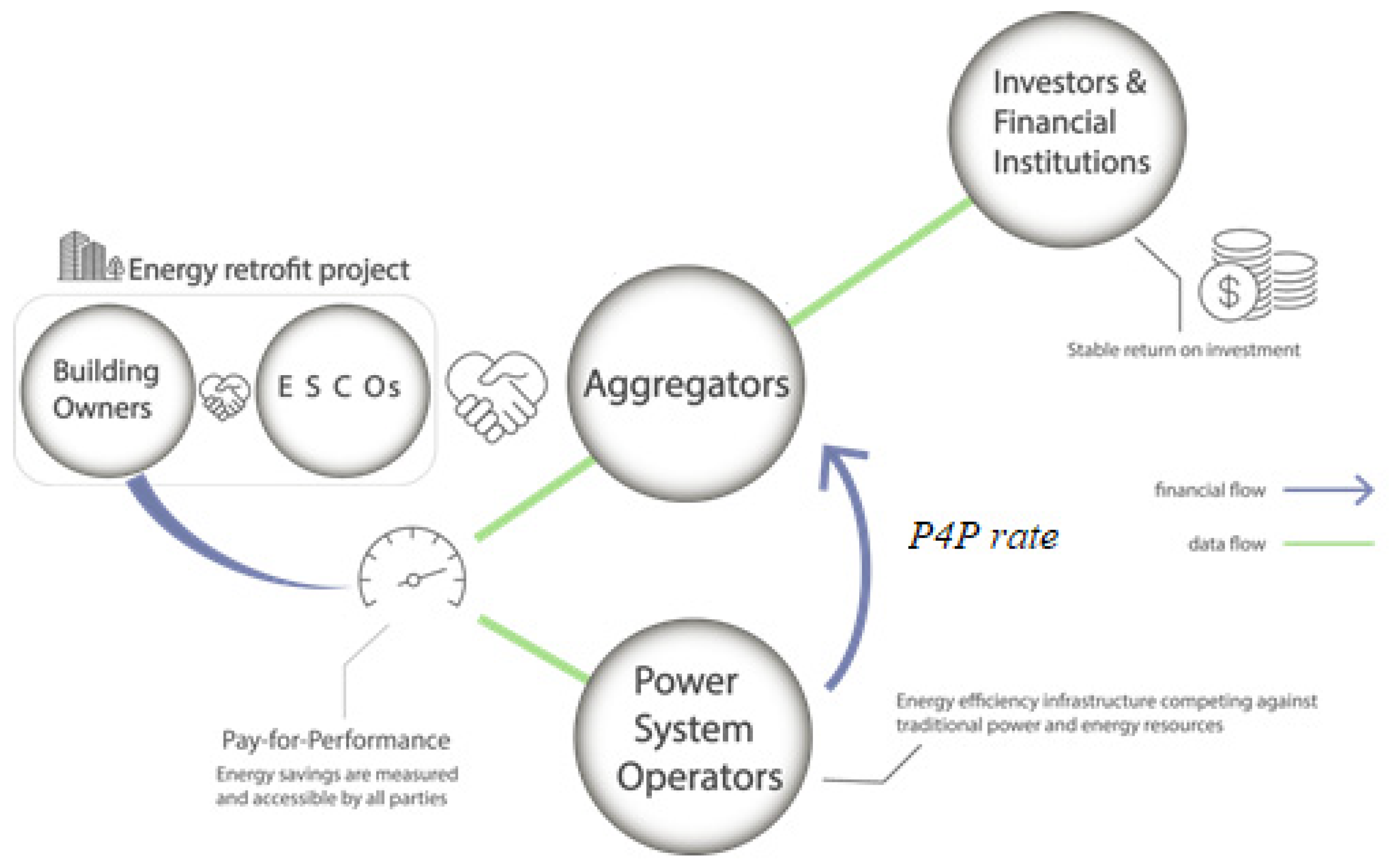1. Introduction
The European Commission has identified that there is a very real opportunity for improving energy efficiency through building renovations. Despite its potential, the current building renovation rates in the EU are very low. One of the main causes of these low rates [
1] is the lack of private investments. In this challenge context, the SENSEI project proposes a new Pay-for-Performance (P4P) business model in the EU.
P4P energy efficiency programmes aim to deliver greater and more persistent energy savings by compensating (paying) energy efficiency resources based on a comparison of metered energy consumption and modelled counterfactual energy consumption. Energy savings are used as the indicator for the energy efficiency project’s performance, and payments are done on an ongoing basis “as the savings occur” [
2]. Payments are channeled from an organization which is willing to pay to support energy savings, usually a public authority or a utility (or other entities) to EE projects. Successful deployment of a P4P scheme is dependent on having detailed knowledge of the possible energy efficiency measures, not only in terms of generated energy savings, but also in terms of grid needs and building or usage characteristics. Therefore, for the P4P scheme devised as part of the SNESEI project an analysis and classification of energy efficiency measures (EEMs) has been devised.
We use the acronym EEMs to refer to both the measures that decrease energy consumption and the deployment of solutions for on-site generation of renewable energy sources and/or or renewables-based solutions for heating and cooling. It is important to consider the value that the energy efficiency measures bring to the overall energy system when dealing with P4P schemes. We should also expect new opportunities for the valorization of energy efficiency by mitigating the need for ramping reserves to address the “duck curve” effect. Assuming that energy providers are both willing and able to take energy efficiency to the markets that can monetize P4P schemes, they can act as the vehicle for compensating energy efficiency as an energy resource [
1].
Investors seek business models that allow energy efficiency improvements to become a commodity that can be shared and/or exchanged. If an investor provides the capital for an energy efficiency retrofit, this investor should have a share on the building’s value. Subsequently, the quantification of the actual monetary value of the achieved energy savings can allow the investor to claim this value. Investor can use P4P schemes to quantify the monetary value of the energy savings and distribute this value accordingly. The energy provider could integrate the monetary value through a channeled payment into P4P scheme by means of the aggregator. This payment called P4P rate is defined from the energy provider’s point of view.
2. Devising the Classes of EEMs
Different measures that affect the daily energy consumption profile have been identified. These include:
Measures that reduce the use of electricity without affecting its temporal profile.
Measures that allow improved control of electricity consumption.
Measures that affect both the electricity used and the hours required to perform a task.
Measures that increase electricity consumption due to fuel substitution.
Measures that install technology for the generation of electricity onsite.
The EU is moving away from the feed-in tariff system towards supporting self-consumption. Overall, seven different categories of EEMs were identified in the analysis carried out in the current investigation, the specific interventions belonging to each of these classes include:
Distributed Generation
Storage
Conversion of the Energy Carrier
Building Intervention
Heating Ventilation Air Conditioning and Domestic Hot Water Systems
Electrical Systems
Building & Automation Control Systems
We structured four different tables for evaluating the EEMs:
Table A: Qualitative analysis of the effects on the grid;
Table B: Technical-qualitative analysis with details of the user-side benefits;
Table C: quantitative table.
For each EEM, a class of “goodness” is calculated, on a scale of 1–10 as shown in
Table 1 below. The classes obtained for each of the aforementioned tables (A, B, and C) are then integrated in a final class of goodness denominated Table X.
An example of the classes of EEMS for the residential sector is shown in
Figure 1.
The classes of EEMs have been contextualized for different sectors: industrial, commercial and residential. To date, most of the P4P programmes outside the EU have been implemented in the commercial and industrial sectors. We included a residential classification of the EEMs because with the deployment of smart meters, the procedure for collecting data becomes less complicated and the cost of whole-building measurement decreases, making measurement and verification (M&V) for P4P more practical for sectors such as residential buildings and SMEs [
3].
3. Estimating the P4P Rates
After identifying the classes of EEMs, the P4P rate concept is devised through the mechanism of the energy efficiency obligation schemes and considering the perspective of the energy provider. The basic idea behind the proposed approach is that the energy providers can set a higher value for P4P rates depending on the class rating of the EEMs.
Here follow some basic concepts and definitions.
A P4P rate can be seen as funds transferred per energy saved. It could be interpreted as a numerical value (€/kWh) that energy providers are willing to pay for each kWh saved or moved to another time of the day. These rates could vary according to the variations of the electricity demand curve (a kWh saved at peak time is worth more than one saved at night/in the valleys). The P4P rates should have the ultimate aim of avoiding network overload (too much electricity transported at peak times) and ensure that the demand curve is aligned with that one of renewable energy production, in order to generate a return economic and environmental return and so allowing utilities to meet energy needs with the maximum percentage of economic and clean energy.
Another term to be explained is energy providers. It can act as system operators distribution companies that are supported by public entities. An energy provider or an energy utility that bids to the capacity market, assuming that generation capacity can be supplemented by energy efficiency retrofits for demand reduction.
3.1. P4P Rates for Complying with EEOS
The Energy Efficiency Obligation Scheme (EEOS) mechanism sets a target based on the energy savings that needs to be achieved by energy companies as obligated parties. Obligated parties have the freedom to achieve the target set for them through various methods, including; providing energy efficiency measures directly to customers, working with intermediaries (trade bodies, municipalities, managing agents) or in some circumstances they can purchase energy savings through a trading mechanism (so-called White Certificates) [
4].
The P4P scheme in SENSEI proposes a mechanism in which energy companies can deliver an energy savings target by providing energy efficiency measures directly to customers (displayed in
Figure 2). The energy companies could introduce P4P rates, incentivizing the SENSEI model to implement energy efficiency interventions as an energy system resource. This would lead to larger savings at lower costs and bring benefits to the overall energy system avoiding capacity, transmission and distribution system costs and enabling greater flexibility in energy consumption.
In order to evaluate P4P rates for complying with the EEOS, distribution companies could use the classes of EEMs mapped in Table C. Table C takes into account the technical-economic aspects of the energy efficiency measure and estimates the costs and savings once a value has been assigned to the tone of oil equivalent (TOE) value. Depending on the classes achieved in Table C the P4P rates level will be indicated in accordance with the
Table 2:
Considering the value of
Table 1 a P4P rate is estimated for each EEMs. This financial support into SENSEI business model shall be paid as an annual incentive payment over multiple years.
3.2. TSO Pespective
The SENSEI project through the role of the aggregator could turn to the TSO to receive an Incentive following the implementation of energy efficiency interventions that bring benefits to the grid. Please see
Figure 3 showing the P4P rate concept in the value chain of the SENSEI business model. An agreement is established between an ESCO and an aggregator of energy efficiency projects. The aggregator creates portfolios of projects, offers the time and location specific power consumption changes from the EEMs to TSO with a mandate to support energy efficiency.
The transition of the electricity system towards complete decarbonization requires activation of all necessary levers for the full integration of renewable production in order to reduce emissions on a long-term basis. To this end, the TSO may have an interest in financing EEMs that could support the SENSEI model with economic incentives (P4P rates) by defining a maximum value to pay. In order to support the TSO development plan, the decarbonization goals particularly (on both an international and national levels, thanks to the intrinsic energy efficiency needs) the EEMs, as evaluated in the table, is the best fit. The calculation of the TABLE X values contains all the types of evaluation carried out in Section 2.3 (contains the analysis and the effects of Tables A–C).
Depending on the class value of table X, the P4P rates level will be defined in accordance with
Table 2. An energy provider could set a higher value for P4P rates the greater the class of the EEMs. The energy provider could be willing to offer the P4P rate as a payment flows into the SENSEI business model.
Author Contributions
Conceptualization, A.L., V.D. and L.P.; methodology, A.L. and L.P.; resources, A.L. and L.P.; data curation, A.L., V.D. and L.P.; writing—original draft preparation, A.L. and L.P.; writing—review and editing, A.L. and L.P.; project administration, A.L.; funding acquisition, A.L. All authors have read and agreed to the published version of the manuscript.
Funding
This research was funded by European Union’s Horizon 2020 Research and Innovation programmed under Grant Agreement No 847066.
Conflicts of Interest
The authors declare no conflict of interest. The funders had no role in the design of the study; in the collection, analyses, or interpretation of data; in the writing of the manuscript, or in the decision to publish the results.
References
- Essert, A.; Dunne, A.; Meeusen, T.; Quashing, S.; Wage, D. Comprehensive Study of Building Energy Renovation Activities and the Uptake of Nearly Zero-Energy Buildings in the EU Final Report; Ipsos: Gent, Belgium, 2019. [Google Scholar]
- Sinai, J. Putting Your Money Where Your Meter Is: A Study of Pay-for-Performance Energy Efficiency Programs in the United State; Natural Resources Defense Council: Berkeley, CA, USA, 2017. [Google Scholar]
- Santini, M.; Thani, D.; Thomas, S.; Stavrakis, V.; Rosenow, J.; Celestino, A. Experience and Lessons Learned from Pay-for-Performance (P4P) Pilots for Energy Efficiency; Deliverable 4.4 SENSEI 2020; SENSEI: Bruxelles, Belgium, 2020. [Google Scholar]
- Jan, R.; Samuel, T. Rewarding Energy Efficiency for Energy System Services through Markets: Opportunities and Challenges in Europe; The Regulatory Assistance Project (RAP): Bruxelles, Belgium, 2020. [Google Scholar]
| Publisher’s Note: MDPI stays neutral with regard to jurisdictional claims in published maps and institutional affiliations. |
© 2020 by the authors. Licensee MDPI, Basel, Switzerland. This article is an open access article distributed under the terms and conditions of the Creative Commons Attribution (CC BY) license (https://creativecommons.org/licenses/by/4.0/).







